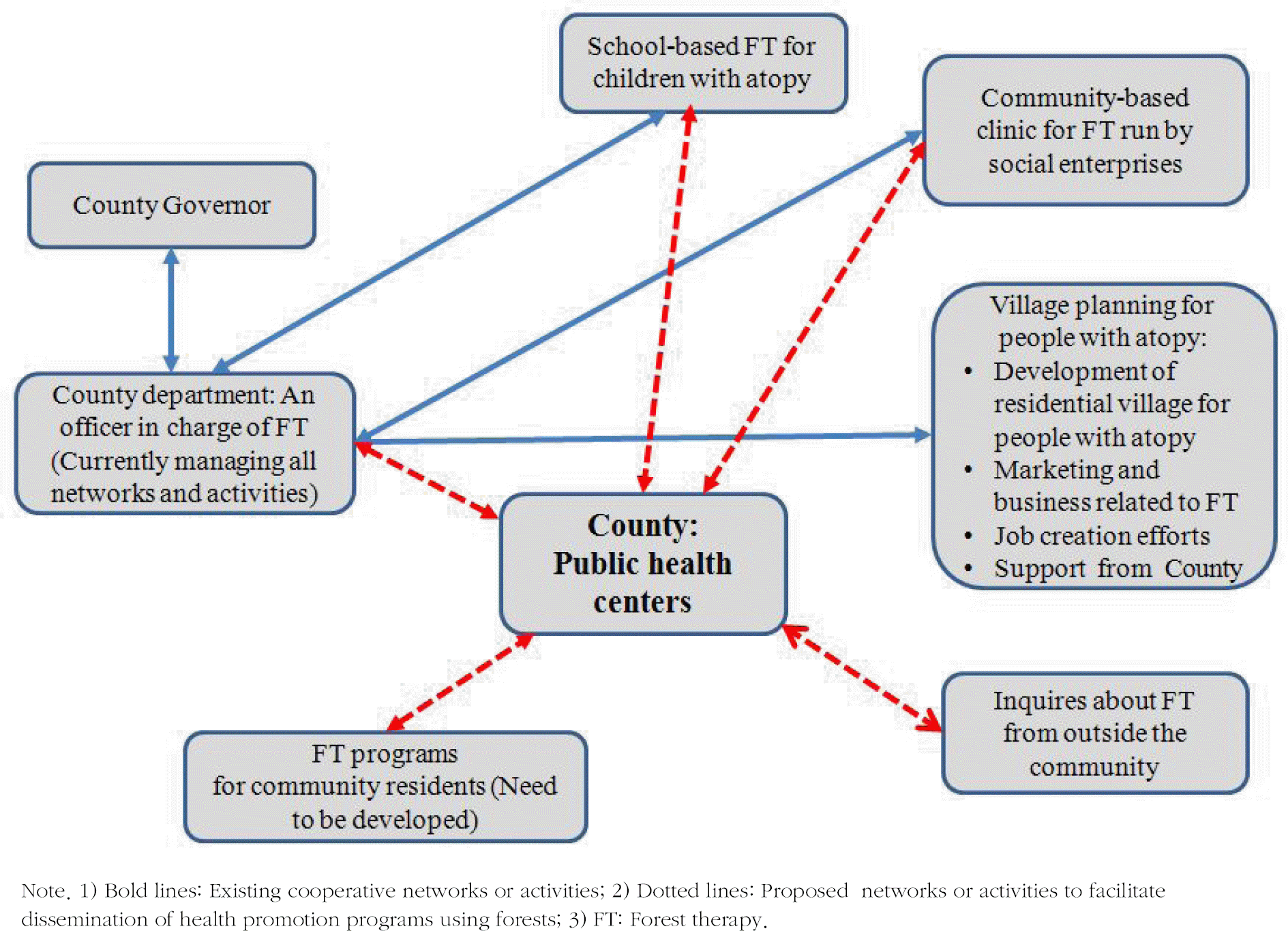Abstract
Purpose
In recent years, many attempts have been made to examine the effects of forest therapy on health and todeveloprelatedpolicies.Thisstudyaimedtoexplorethecurrentstatusofhealthpromotionprogramsusingforests providedbypublichealthcentersandtoidentifyprogramdiffusionstrategiesemployedwithindifferentcommunities.
Methods
For this descriptive study, we analyzed the 5th regional public health care programplans and explored theperceptions of health careworkers attachedwith theprogramsusing open-endedquestionnaires and a focus groupinterview.
Results
This study confirmed the necessity for health promotionprograms using forests, as well asadministrativeandeducational demandsforsuchprograms. Thetarget populationoftheprogramsrangedfrom individualswithspecificdiseasestohealthylocalresidents. Inaddition, the programs covered a wide range of topics, including disease management and health promotion strategies. However, the number of well-structured regional specialized programs remain edlimited. Collaboration among local governments, schools, and public health centers was found to be in effective.
References
1. Korea Forest Service. [Forest Welfare Master Plan]. Daejeon: Korea Forest Service;2013.
2. KimKW.Theoreticalstudy of characteristics of therapeutic elements and application to forest therapy. J Korean Soc People Plants Environ. 2006; 9(4):111–23.
3. Kim KW. Technical methods for enhancing the health effect intherecreational forest. J KoreanSoc PeoplePlants Environ. 1999; 2(4):1–11.
4. Kang MJ, Kwak KH, Ahn YS, An KW, Kim EI. Basic plan for creating a healing forest in Jangheunggun. J Korean isl. 2011; 23(2):103–20.
5. Cha J, Kim S. Healing effects of the forest experience on alcoholics. J Korean Acad Nurs. 2009; 39(3):338–48. http://dx.doi.org/10.4040/jkan.2009.39.3.338.

6. Lee JH.Characteristicsof naturebased recreation inGermany – a view from the historical background and laws. J Korean Inst For Recreat. 2010; 14(4):81–91.
7. Maller C, TownsendM , Pryor A, BrownP , St Leger L. Healthy nature healthy people: ‘contact with nature' as an upstream health promotion intervention for populations. Health Promot Int. 2006; 21(1):45–54. http://dx.doi.org/10.1093/heapro/dai032.

9. Yoo RH, Kim JW, Ha SY, Yoon EY, Kim JJ.Analysis of the internal and external case using therapeutic function of forests. In: [KoreanForest SocietyConference]; 2007Aug 30–31; Wonju, Korea. Seoul: Korean Forest Society;2007. p. 462–3.
10. Woo JM, Park SM, Lim SK, Kim W. Synergistic effect of forest environment and therapeutic program for the treatment of depression. J Korean For Soc. 2012; 101(4):677–85.
11. Kim S, Kim HJ, Lee KJ, Lee SO. [Focus Interview Method]. Seoul: Hyunmoon;2000.
12. Forest Therapy Society. Forest Therapy Total Web [Internet]. [place unknown]: Forest Therapy Society; [cited 2013 Feb 5]. Available from:. http://www.fo-society.jp.
13. An KW, Lee KH, Jeon KS, Yoo RH, Park JS, Kim SL. A case study of forest therapeutic programs in Japan. In: [2007 Conference of Korean Institute of Forest Recreation]; 2007 Apr; Korea. [place unknown]: Korean Institute of Forest Recreation;. 2007. 61–7.
15. Lee JH, Burger-Arndt R. Understanding the healing function of urban forests in German cities. J Korean Inst For Recreat. 2011; 15(3):81–9.
16. Kim SC, Han YH, Park KU, Oh HK. Improvement methods of theforest therapeutic functioninrecreational forest. J Korean Inst For Recreat. 2008; 12(4):1–8.
Table 1.
Health Care Programs Provided by Public Health Centers
Table 2.
Life-cycle based Programs using Forests




 PDF
PDF ePub
ePub Citation
Citation Print
Print



 XML Download
XML Download